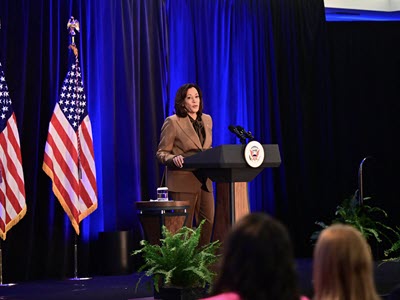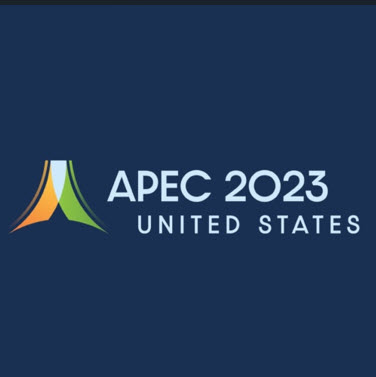APEC’s Progress on Women’s Economic Empowerment during the U.S. Host Year
Geeta Rao Gupta, Ambassador-at-Large for the Secretary’s Office of Global Women’s Issues at the U.S. Department of State, looks back at the achievements of the APEC Women and the Economy Summit since the inaugural 2011 meeting. She describes Vice President Kamala Harris’s participation in the 2023 APEC meeting in Seattle and outlines four core priorities related to the most significant economic barriers that women face in the APEC region that guide what is now called the Women and the Economy Forum.
NBR is grateful to the Hinrich Foundation for its generous support of this commentary.
At the Asia-Pacific Economic Cooperation (APEC) Economic Leaders’ Week in November 2023, the culminating event of the United States’ APEC host year, Vice President Kamala Harris said, “We are all here because we agree women around the world should be able to fully participate in economic, political, and social life, and they must be able to participate equally and in positions of leadership.” Her statement echoed comments made by former secretary of state Hillary Clinton on September 16, 2011, when she launched the first-ever APEC Women and the Economy Summit during the United States’ 2011 host year. Recognizing the power of women as drivers of growth, former secretary Clinton stood before APEC economies to make the case for unlocking the economic potential of women, breaking down barriers, and including women in all economic sectors across the region, ushering in a “participation age.”
I was not part of those meetings back in 2011, but from my role today as the U.S. ambassador-at-large for global women’s issues, I know how far we have traveled since then. At the first APEC Women and the Economy Summit—itself an enormous feat—APEC economies issued the San Francisco declaration. It was remarkable in its focus and galvanized international commitment to improving women’s access to capital and markets, building women’s capacities and skills, and supporting the rise of women leaders in both the public and private sectors. This focus represented a bold, transformational shift. The 21 APEC economies include 2.95 billion people whose contributions accounted for 62% of world GDP and 48% of world trade in 2021. So economic advancements in APEC, especially for women, have significant implications for the global economy. That is why this meeting, now called the Women and the Economy Forum (WEF), has served as an important annual stocktaking of progress toward those goals and allowed us to identify roadblocks and correct course as needed.
Vice President Harris was clear-eyed when she noted to our fellow APEC economies in November that women’s economic security and full and equal participation will be essential to addressing the current challenges faced by APEC economies. Twelve years on from former secretary Clinton’s aspirational remarks on the same themes, this truth has become a shared compass for all APEC economies, which have remained committed to the greater integration and empowerment of women in the Asia-Pacific region.
Over the past decade, we have launched several successful skill-and capacity-building programs for women across the APEC region, along with tools to measure progress. For example, in 2015, APEC economies established the APEC Women and the Economy Dashboard, which provides a snapshot of the status of women in the region by monitoring trends over the years using a set of 95 quantitative indicators. The most recent 2023 dashboard update shows significant progress in women’s access to finance and credit, with the gender gap narrowing by 3.4 percentage points since 2011.
Furthermore, women in APEC have remained almost on par with men in terms of literacy and educational attainment. While maternal mortality rates in the APEC region have declined significantly (from 70 out of 100,000 live births in 2011 to 28 in 2021), APEC has continued to address health-related barriers that women in the region face to entering, remaining, and advancing in the workforce. The United States stood up the APEC Healthy Women, Healthy Economies initiative with other APEC economies and published the “Healthy Women, Healthy Economies Literature Review,” among other efforts. To chart a clear path forward to advance women’s economic empowerment in APEC and drive sustainable growth in the region, APEC economies endorsed the La Serena Roadmap for Women and Inclusive Growth in Chile in 2019. This document remains the north star for women’s economic empowerment efforts in the region.
Today, we are living through unprecedented challenges that threaten to derail this progress. A convergence of compounding crises—the aftermath of the Covid-19 pandemic, armed conflicts, humanitarian emergencies, and democratic backsliding—has put our global gender equality trajectory in peril. Compared with 2019, when it was estimated that closing the gender gap would take 99.5 years, the World Economic Forum now estimates that it will take 131 years to achieve gender parity at the current rate of progress. And that is if we can sustain the will to even try. According to the UN Development Programme, around 90% of men and 87% of women hold internal biases against women, roughly the same number as decades ago.
Using the inaugural 2011 meeting’s focus areas as a guide, and against a backdrop of multiple crises and technological upheaval, the United States organized the 2023 WEF meetings on August 18–20 in Seattle. At those meetings, I joined the U.S. WEF chair, White House Gender Policy Council director Jennifer Klein, in multiday sessions centered on accelerating women’s economic empowerment, participation, and leadership, supporting the U.S. APEC host year priorities of “interconnected, innovative, and inclusive.” We focused the WEF around four key pillars related to the most significant economic barriers that women face in the APEC region: (1) advancing women’s leadership in the gender-climate nexus, (2) increasing equity and equality in global value chains, (3) expanding digital and STEM inclusion and innovation, and (4) strengthening care infrastructure. And because of our shared compass, APEC economies were able to spend time and resources on fueling the drive forward rather than figuring out where we are headed, and why.
As outlined in the chair’s statement, the WEF brought together 21 diverse APEC economies to address the way forward on these four core priorities and paved the way for robust gender integration during the APEC Economic Leaders’ Week in November.
On the first priority, the gender-climate nexus, the United States initiated the development of the Seattle Framework on Gender Equality and Climate Change. This is an initiative to inform policymakers on different approaches to address the disproportionate impacts of environmental challenges—including climate change, extreme weather, and natural disasters—on women and girls of diverse backgrounds and those living in remote and rural areas. We are anticipating that this framework will eventually become the blueprint that APEC economies use to confront these challenges.
During the APEC Economic Leaders’ Week, Vice President Harris announced a new initiative called Women in the Sustainable Economy (WISE), which aims to bolster women’s economic empowerment globally by expanding access to employment, training, leadership roles, and financial resources in critical blue and green industries. The initiative has already garnered $1.4 billion in commitments from governments, civil society, and the private sector. My office is proud to support WISE through our Building Economic Inclusion via the Blue Economy program to support women entrepreneurs and young professionals in the maritime sector.
To advance the second priority geared toward increasing equity and equality in global value chains, collaborative work between the U.S. Departments of State and Commerce focused on empowering women-owned small businesses in the Asia-Pacific region, which will promote supply chain resiliency and inclusive economic growth. On August 20, the United States supported a joint ministerial meeting focused on expanding the access of women-owned, -led, and -managed micro, small, and medium-sized enterprises to global value chains and promoting women’s entrepreneurship through cross-border e-commerce. The United States cosponsored and participated in events and public and private sector policy dialogues alongside the APEC meetings that focused on local women-owned, -led, and -managed small businesses in Seattle, including Native-owned businesses. These meetings yielded new private sector commitments on supply chain equity, including Boeing’s offer to engage WEF economy representatives on education and mentorship programming, such as bidding simulations, for women-owned businesses. In addition, to help increase the capacity of APEC economies to support women-owned businesses’ participation in government corporate procurement and broader access to global value chains, the United States released the report “Women in Global Value Chains: An APEC Benchmarking Study.”
In support of the third priority, expanding digital and STEM inclusion and innovation, the United States focused, through events on “women in the digital world” and “women in e-commerce,” on increasing access to markets for women-owned businesses through cross-border e-commerce and closing the gender-digital divide. The latter is critical to promoting economic opportunity, inclusion, and leadership in a dynamic digital economy transformed by emerging technology. We also supported an APEC Digital Month event focused on artificial intelligence (AI) and occupational segregation. Additionally, we discussed with partners how to elevate the role of women and girls with disabilities as innovators and creators, address the growing global phenomenon of technology-facilitated gender-based violence, and promote women and girls in STEM. Private sector commitments resulting from the discussions we convened include the Microsoft Center for Inclusion’s offer to engage APEC economies to cooperate on financial inclusion, such as by unlocking financing for women entrepreneurs in the region through innovative pathways.
Finally, to strengthen care infrastructure, the United States convened several policy discussions with members of the private sector, civil society, and international partners to discuss strategies toward building a robust, equitable care economy. These sessions addressed the need to close gender care gaps, invest in innovative tools and approaches to increase access and affordability, and expand partnerships for care infrastructure. With our partners at the Department of Labor, the United States proudly supported the development of the APEC Embracing Carers Policy Toolkit to close the unpaid care gender gap and share best practices on these issues.
The United States is not doing this work alone. More than one hundred private sector leaders and nearly three hundred officials from the APEC economies participated in these meetings in Seattle in August. Private and nonprofit partners worked with my office to co-lead seventeen policy discussions and events with eight U.S. federal agencies and the White House Gender Policy Council. Private sector partners shared tools to address priority challenges, from advancing women as climate innovators, managing the effects of climate change on women’s health, and accelerating women’s renewable and clean energy careers to increasing their access to the digital economy—including AI—and STEM education, training, and technical and policy careers.
I am proud of what we achieved during the United States’ APEC host year, but I am also under no illusions that all of our challenges have been solved. The WEF and the other APEC engagements that the United States, in coordination with our partners, organized to advance women’s economic security in the region gave us an opportunity to take a look at our roadmap, make course corrections, and recharge our batteries through new initiatives and commitments. In 2024, we are back on the road, determined to continue working with our fellow APEC economies to leverage the progress made to keep moving ahead toward our commonly defined finish line: a reality in which all women and girls—in the Asia-Pacific region and around the world—are able to fully, meaningfully, and equally contribute to, and benefit from, economic growth and prosperity.
Geeta Rao Gupta is Ambassador-at-Large for the Secretary’s Office of Global Women’s Issues at the U.S. Department of State. Ambassador Gupta previously served as senior fellow at the United Nations Foundation and senior advisor to Co-impact, a global collaborative philanthropy for systems change. Prior to that, she served as deputy executive director for programmes at UNICEF and for over a decade as president of the International Center for Research on Women, a nonprofit based in Washington, D.C.



